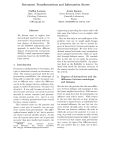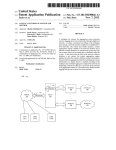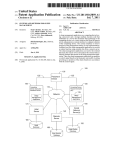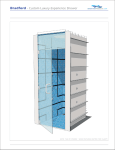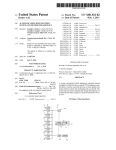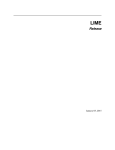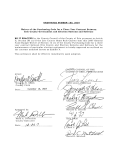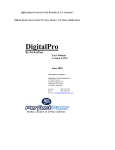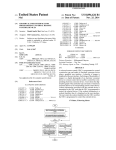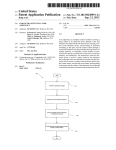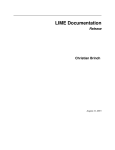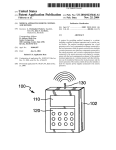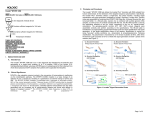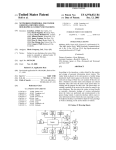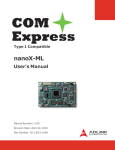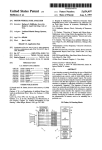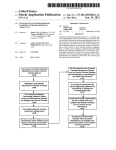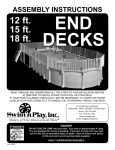Download Systems and methods for sleep management
Transcript
US008749360B2 (12) United States Patent (10) Patent N0.: (45) Date of Patent: Chraime et a]. (54) (56) SYSTEMS AND METHODS FOR SLEEP MANAGEMENT US 8,749,360 B2 Jun. 10, 2014 References Cited U.S. PATENT DOCUMENTS (75) Inventors: Sean Chraime, Brooklyn, NY (US); 6,229,430 B1 6,928,031 B1 Micah Collins, Brooklyn, NY (US); Andrew Skurdal, Jersey City, N] (U S); Ezra Ashkenazi, Rahway, N] (U S) 5/2001 Smith Dewey 8/2005 Kanevsky et a1. 2003/0001727 A1* 2004/0160337 A1* 2005/0104720 A1* 1/2003 8/2004 5/2005 2009/0016166 A1 (73) Assignee: SDI Technologies, Inc., Rahway, NJ (Us) Steinmark .............. .. 340/309.15 Auyang et a1. . .... .. 340/825.24 Chon et al. ............. .. 340/309.16 1/2009 Abuelsaad 2009/0303066 A1* 12/2009 Lee et a1. .................... .. 340/679 * cited by examiner Notice: Subject to any disclaimer, the term of this patent is extended or adjusted under 35 Primary Examiner * Mohammad Ghayour U.S.C. 154(b) by 531 days. Assistant Examiner * Mark Rushing (74) Attorney, Agent, or Firm * Leason Ellis LLP (21) Appl. No.: 12/984,398 (22) Filed: (57) Jan. 4, 2011 ABSTRACT A sleep management application on a computing device hav (65) Prior Publication Data US 2011/0163859A1 ing a processor and a storage medium executes code that establishes to a server that maintains data pertaining to the computing device or to a user, retrieves data from the remote server, and generates a custom interface to con?gure a feature Jul. 7, 2011 Related US. Application Data (60) of the computing device. The custom interface is used to program a sleep management setting. In one implementation, a method uses the sleep management application to provide Provisional application No. 61/292,103, ?led on Jan. 4, 2010. an alarm function using external data from a remote server. (51) Int. Cl. G08B 21/00 (52) The sleep management application can receive the external data from the remote server and analyze the external data to (2006.01) US. Cl. identify elements that pertain to the sleep management appli cation. Then, the sleep management application can generate USPC ............ .. 340/309.16; 340/309.3; 340/286.02; 340/575; 340/384.1; 368/9; 368/13 (58) a control signal based on the elements, and modify a setting governing an operation of the alarm function in accordance Field of Classi?cation Search With the control signal. USPC ....... .. 340/309.3, 309.16, 575, 286.02, 384.1; 368/9e14 See application ?le for complete search history. 15 Claims, 14 Drawing Sheets / 100 f 105 125 X Peripheral K135 Device 120 \ f 130 Computing 110 Computing Device: Device: Consumer Electronic Device Personal Computer C) 1 15 : ------ -- Sleep Network 1 |---(—-—_ | Sleep : | Management 1 : Management l | Application | | Application l _ L 2 2 2 2 i 2 2 _ _ _ 170 \ _ _ _ l | _ J f1 90 Social Seal/2r / 140 Nelwmk Server(s) Remote 180 150 Hotel Database 160 Audio Device Database User Account Database US. Patent Jun. 10, 2014 K 125 \ US 8,749,360 B2 Sheet 1 0f 14 f 105 100 [ 135 Peripheral Device 120 x f 130 Computing Computing Device: Personal Computer Device: Consumer Electronic Device Network Sleep I | Management l : Management | | Application 1 L Application : f 190 170x Hotel Server K 140 Social Network Serve r(s) Remote Server 180 150 Hotel Database 160 Audio Device Database User Account Database FIG. 1 US. Patent I _ _ _ _ ' _ _ _ Jun. 10, 2014 — _ _ _ _ _ _ _ _ _ — _ _ " " Sheet 2 0f 14 _ _ _ _ _ _ _ _ _ _ _ _ _ US 8,749,360 B2 _ _ _ _ _ _ _ _ _ _ — _ _ _ _ _| | 1 260 ' K II II Network Connector(s) 21 O | K 215 M emory I KPower _ _ I| II Ampll?er I ' I I 255 \ | Digital NO 220 Connector(s) | I Connector(s) ' I l | l I Microcontroller I I _ _ _ _ _ _ _ _ _ _ _ _ I 250 \ Analog IIO | j I I ' I I Display I I I I | l I l | | I DOCking I I 1 I I I I Connector I [-230 I I I | I | I \ | | ' | I I | ]R Receiver ' Radio I Control I I Tuner(s) I I Panel I | | I i I l I : I I ' I | I | US. Patent Jun. 10, 2014 Sheet 3 0f 14 US 8,749,360 B2 User Account Database [- 300 W User Identification Information 0 / 320 login name and password User Preference Information 0 0 e-mail address(es) - personal web site(s) 0 social network(s) info f 330 alerts and advertisements o user’s buddy list User Activity Information 340 - current location - current activity 0 planned activities / User Personal Data /‘ o audio/video files User Sleeg Profiles o / 360 profile_1 profile_2 _ _ Sleep Manaqement Anollcation 0 / 370 software version ID Peripheral Device o 350 manufacturer and model FIG. 3A / 380 310 US. Patent Jun. 10, 2014 Sheet 4 0f 14 User Sleep Profile US 8,749,360 B2 / 360 Wake Up Options 0 alarm time alarm duration o 0 alarm sound 0 / 365 sound source 0 0 snooze option action list Bedtime Options . o bedtime 375 bedtime sound 0 0 sound source f sound duration 0 action list Miscellaneous Options 0 - alarm time alarm duration 0 alarm sound 0 sound source o snooze option 0 action list FIG. 3B 385 / US. Patent Jun. 10, 2014 Sheet 5 0f 14 US 8,749,360 B2 Peripheral Device/Computing Device Database K— 400 W l 420 Device Model Identifier _ _ _ / Devrce Con?guration Data [ Device User Manual f 430 450 _ Devrce Software Update f 460 f 470 Application Program interfaces FlG. 4 410 US. Patent Jun. 10, 2014 Sheet 6 0f 14 US 8,749,360 B2 500 \ Download Sleep Management Application [510 on Consumer Electronic Device or PC l Install Sleep Management Application on the Consumer Electronic Device or PC l Sleep Management Application Creates User Account(s) l Application Collects/Updates User Preferences and User Activity information l Application Collects/Updates information about Consumer Electronic Device or PC l User Creates Sleep Profiles l Sleep Management Application Connects to the Remote Server using internet l Application Sends Collected/Updated information to the Remote Server FIG. 5 f 580 US. Patent Jun. 10, 2014 Sheet 7 0f 14 US 8,749,360 B2 600 x Consumer Electronic Device is Docked with the Peripheral Device l Sleep Management Application Starts on the Consumer Electronic Device l Application and Consumer Electronic Device Authenticate Each Other l Sleep Management Application Connects to the Remote Server Sleep Management Application Retrieves Configuration Information for the Peripheral Device Application Generates a Custom Graphic User Interface for the Peripheral Device based on Configuration information V Sleep Management Application Retrieves User Personal Data and Sleep Profile(s) Sleep Management Application Configures Peripheral Device using Custom User interface and Sleep Profile(s) FIG. 6 / 680 US. Patent Jun. 10, 2014 Sheet 8 0f 14 US 8,749,360 B2 700 \ Sleep Management Application Connects [-710 to and Authenticates Peripheral Device I Sleep Management Application Collects User Location Information Based on the Authentication Information I Sleep Management Application Sends User Location Information to Remote Server(s) Based on User Preferences I Sleep Management Application Collects User Activity Information Based on Configuration of the Peripheral Device I Sleep Management Application Sends User Activity Information to Remote Server(s) based on User Preferences I Application Detects Activation of Control Button(s) 0n the Peripheral Device / 760 I Sleep Management Application Sends User Activity Updates Message to Remote Server(s) based on User Preferences FIG. 7 / 770 US. Patent Jun. 10, 2014 Sheet 9 0f 14 800 \ Sleep Management Application Connects to the Remote Server I Sleep Management Application Retrieves User Activity Information I Sleep Management Application Analyses User Activity Information I Sleep Management Application Presents Activity Information in a Graphical or Statistical Form I Sleep Management Application in Response to the User Command Reorganizes the User Activity Information in Different Formats I Sleep Management Application in Response to the User Command Retrieves Additional Information About User Activities I Sleep Management Application in Response to the User Command Transmits the User Activity Information to Remote Server(s) FIG. 8 US 8,749,360 B2 US. Patent Jun. 10, 2014 Sheet 10 0f 14 900 X Remote Server Creates a User Account i Remote Server Receives/Updates Information about Peripheral Devices i Remote Server Receives/Updates User Preferences Information l Remote Server Receives/Updates User Location information l Remote Server Receives/Updates User Activity information l Remote Server Updates User’s Personal Web Site and Social Networks with the User Activity and Location Information Based on User Preferences i Remote Server Sends Messages to the Buddy List Based on User Preferences FIG. 9 US 8,749,360 B2 US. Patent 1000 Jun. 10, 2014 Sheet 11 0f 14 US 8,749,360 B2 X Sleep management Application Connects / 1010 to and Authenticates Peripheral Device l Sleep Management Application / 1020 Connects to the Local Hotel Server l Sleep Management Application Retrieves / 1030 Information About Hotel Services Sleep Management Application Receives User Request(s) for Hotel Services l Sleep Management Application Sends User / 1050 Request(s) to the Hotel Server l Sleep Management application Receives / 1060 Confirmation from the Local Hotel Server l Sleep Management Application Presents Con?rmation in a form of an Alert FIG. 10 [1070 US. Patent 1100 Jun. 10, 2014 Sheet 12 0f 14 \ Sleep management Application Connects to and Authenticates Peripheral Device I Sleep Management Application Determines User Location Information Based on Authentication Information I Sleep Management Application Checks User Preferences Information I Sleep Management Application Searches for Information about Local Businesses and Services Based on User Preferences I Sleep Management Application Presents Information about Local Businesses and Services to the User in form of Alerts I Sleep Management application Presents Advertisements from Local Businesses and Services I Sleep Management Application Places Orders for Local Businesses and Services FIG. 11 US 8,749,360 B2 US. Patent 1200 Jun. 10, 2014 Sheet 13 0f 14 w 1202 \ INITIATE/ESTABLISH COMMUNICATIONS LINK WITH SERVER(S) 1204 N I RECEIVE EXTERNAL DATA 1206 \ I ANALYZE EXTERNAL DATA 1208 \ l GENERATE CONTROL SIGNAL BASED ON PERTINENT DATA ELEMENTS 1210 \ I MODIFY SETTINGS/ OPERATIONS/FUNCTIONS IN ACCORDANCE WITH CONTROL SIGNAL FIG. 12 US 8,749,360 B2 US 8,749,360 B2 1 2 SYSTEMS AND METHODS FOR SLEEP MANAGEMENT are received dynamically from an external source that may transform or otherwise alter the user’s or the device’s set tings. As such, changes in local weather or traf?c can in?u ence the settings in the peripheral device, and so can changes CROSS-REFERENCE TO RELATED APPLICATIONS based on other information received from a remote source, all The present application claims the bene?t of US. patent application Ser. No. 61/292,103, ?led Jan. 4, 2010, which is tion. As a result, for example, an alarm function of a periph eral device or the computing device itself can be adjusted even while the user sleeps to account for such changes. according to the operation of the sleep management applica hereby incorporated by reference in its entirety. According to one aspect, the sleep management applica tion cooperates with a computing device having a processor TECHNICAL FIELD OF THE INVENTION and a storage medium. The sleep management application This disclosure relates generally to the ?eld of consumer utilizes one or more software modules that are stored on the electronic devices and, in particular, to systems and methods in support of enhanced consumer electronic devices for sleep storage medium and executed in the processor. The sleep management application operates by establishing a commu management. nications link with a server that maintains data pertaining to the computing device or to a user. The sleep management application retrieves data from the remote server and gener ates a custom/tailored interface based on the data in order to BACKGROUND OF THE INVENTION Alarm clocks have traditionally been used as a primary 20 means for sleep management. These devices usually provide limited alarm settings options including what sounds are played when the alarm is triggered. In traditional alarm clocks, sound options are usually limited to an alarm, a radio or an audio CD. The user typically has the ability to manually agement setting using the custom/tailored interface to imple 25 preselect which type of sound is played, and sometimes has the option of ?rst playing one type of sound, then playing another type of sound after a predetermined time period. The user can also preselect the radio station or CD that is to be played. In the case of a radio station, the user may preselect a radio station that plays a certain type of audio content, such as options. For example, a consumer electronic device may be con?gured to function as an alarm clock. The device may also be connected to the traditional alarm clock and be used by the user to con?gure alarm settings and to select audio content to be reproduced on the alarm clock. In addition, various consumer electronic and computing executed in the processor. A communications link between the sleep management application and a remote server is initiated, the remote server having external data pertaining to the computing device or to a user. The sleep management application receives the external data from the remote server 35 and analyzes the external data to identify elements that per tain to the sleep management application. Then, the sleep management application generates a control signal based on the identi?ed elements and modi?es a setting governing an 40 devices have frequent, if not constant network connectivity. These devices are capable of receiving a vast amount of information from remote data servers through the Internet. For example, it is common for users of capable devices to ment the feature so-con?gured. According to another aspect, a computer implemented method for enhancing a sleep management application oper ating on a computing device and having an alarm function is provided. The computing device has a processor and a storage medium, and the sleep management application has one or more software modules stored on the storage medium and 30 a light jaZZ radio station or the like. However, the recent proliferation of consumer electronic and computing devices having various software applications and extensive interop erability has signi?cantly expanded user’ s sleep management con?gure a feature of the computing device. Then, the sleep management application is programmed with a sleep man operation of the alarm function of the computing device in accordance with the control signal. According to yet another aspect, a computer implemented method for enhancing a sleep management application oper ating on a computing device is provided. The computing device has a processor and a storage medium, and the sleep 45 receive tra?ic and/or weather updates for a speci?c location. In many instances, various elements within this received management application has one or more software modules stored on the storage medium and executed upon the proces sor to cooperate therewith and implement enhanced sleep information result in additional considerations for a user. For management functionality. The sleep management applica instance, if a weather forecast predicts inclement weather, tion collects data that is perceptible to, or usable by, the and/ or a traf?c report indicates delays on a certain road, a user 50 computing device and analyzes the data to identify elements that pertain to the sleep management application. The sleep management application then generates a control signal may wish to account for these current/ future events by wak ing up at a time other than that which he/she is otherwise accustomed. However, there is presently no system or method that enables such accounting and/ or considerations to be effectively implemented. based on the identi?ed elements and modi?es the operation of the sleep management application in accordance with the 55 tem is provided including a processor, a storage medium disclosure made herein is presented. SUMMARY OF THE INVENTION 60 Technologies are presented herein for a system and method link with a remote server, the remote server having external data pertaining to a computing device or to a user. The soft In accordance with a broad aspect of the invention, a com control that executes either a user’ s settings or settings that accessible by the processor, and one or more software mod ules encoded on the storage medium which execute in the processor and which, when executed by the processor, cause the sleep management system to initiate a communications for enhancing a sleep management application. puting device executes code that implements a sleep manage ment application which can, in certain implementations, pro vide control over a peripheral device, and, more particularly, control signal. According to yet another aspect, a sleep management sys It is with respect to these considerations and others that the 65 ware modules, in cooperation with the processor, further cause the sleep management system to receive the external data from the remote server and analyze the external data to identify elements that pertain to the sleep management appli US 8,749,360 B2 3 4 cation. Then, the software modules cause the sleep manage software modules that provide con?guration and storage of various sleep management settings for the peripheral device ment system to generate a control signal based on the identi ?ed elements and modify a setting governing an operation of 105, including but not limited to clock settings, alarm set an alarm function in accordance with the control signal. tings, radio settings, audio settings, network settings, user pro?le settings and various other con?guration parameters and settings. The sleep management application 115 may be provided by the manufacturer of the peripheral device 105, BRIEF DESCRIPTION OF THE DRAWINGS FIG. 1 illustrates a schematic block diagram of a sleep the manufacturer of the computing device 120, 130, or a third management system in accordance with one example party. In one example embodiment, the sleep management embodiment; application 115 may be written and distributed by the manu facturer of the peripheral device 105, such as the manufac FIG. 2 illustrates a schematic block diagram of a peripheral device, such as an alarm clock, in accordance with one turer of an alarm clock radio. In another example, the manu facturer of the audio reproduction device 105 may provide example embodiment; Application Programming Interfaces (APIs) to the peripheral FIGS. 3-4 illustrate schematic block diagrams of databases maintained by the sleep management system in accordance devices 105 so that third-party software developers can create with one example embodiment; FIGS. 5-12 illustrate ?ow diagrams of the methods of their own sleep management applications 115 using the pro vided APIs. The application 115 may be executed by the operation of the sleep management system in accordance operating system (OS) or the Internet browser of the con sumer electronic device 120 and/or personal computer 130. with one example embodiment; and FIG. 13 illustrates a schematic block diagram of a com 20 puter system in accordance with one example embodiment. The sleep management application 115 may be written using C, C++, Perl, Java, Visual Basic, XML, HTML and other known programming languages. The system 100 may further include various local and remote servers 140, 170, 190 that operate in conjunction with DETAILED DESCRIPTION OF CERTAIN EMBODIMENTS OF THE INVENTION 25 Example embodiments are described herein in the context of systems, methods and computer program products for sleep management. Those of ordinary skill in the art will realize that the following description is illustrative only and is not intended to be in any way limiting. Other embodiments 30 the sleep management application 115 to provide various information and services to the sleep management applica tion 115, consumer electronic device 120, personal computer 130, peripheral device 105, and/or application users. In one example embodiment, the system 100 may include a remote server 140 hosted by the manufacturer of the peripheral will readily suggest themselves to such skilledpersons having device 105 or a third party. In one embodiment, server 140 the bene?t of this disclosure. Reference will now be made in detail to implementations of the example embodiments as may maintain and provide to the sleep management applica tion 115 information about various peripheral devices 105, illustrated in the accompanying drawings. FIG. 1 illustrates a schematic block diagram of a sleep management system 100 in accordance with one example 35 database 160. In another example embodiment, the peripheral embodiment. The system 100 includes one or more peripheral device 105 may be located in a hotel, in which case, the system 100 may include a local hotel server 170 and hotel devices 105, such as an audio reproduction device (for example, an alarm-clock radio or a similar device having audio reproduction functionality such as a speaker as one example of an output device for providing an alert to a user as database 180. The sleep management application 115 may 40 computing device such as a consumer electronic device 120 and PC 130 may be connected to the peripheral device 105 via dedicated analog/digital connectors 125 and 135, respec tively, and/or via a wired or wireless, network 110, such as communicate with the hotel server 170 via network 110 to provide and/or receive information about various hotel ser part of the alarm function). The system 100 further includes a (for example, a smart phone, portable audio/video player, personal digital assistant (PDA), digital reader, or any other type of electronic device having data processing/storage capabilities), and/or a personal computer 130 (for example, a desktop, laptop, tablet, or notebook computer). Device 120 which may be stored in a database 150, and serve as a backup for the user account information, which may be stored in a 45 vices. In yet another example embodiment, the system 100 may include various social networking and/or messaging servers 190. The sleep management application 115 may provide and/or receive status update noti?cations about activities of the application user or other users to/from the social networking servers 190, such as Twitter® or Face book®, or send email or instant messages with the user activ ity information using messaging servers 190. Operation of 50 these and other servers will be described in greater detail herein below. Ethernet, 802.11b/g/n, and Bluetooth. In one example, the In an alternate arrangement, sleep management application consumer electronic device 120 may be docked with the peripheral device 105, in which case the connector 125 may 115 can be con?gured to receive information from one or more servers 140, 170, 190, and to further utilize the received and/or analog input/output ports. In one example embodi information to enhance and/or modify the operation of the sleep management application 114 including an alarm func ment, the connector 125 may be a Universal Serial Bus (U SB) tion. By way of example, sleep management application 115 be a generic or custom docking connector having digital 55 connector or other types of serial data connectors. In one can utilize the computing device’s 120, 130 existing Internet example embodiment, the connector 125 may include a cable. connection to initiate a connection between the sleep man The personal computer 130 may be connected to the periph 60 can then receive external data (i.e., data that is present on the server 140, 170, 190 but not on the computing device 120, nectors. The system 100 further includes a sleep management application 115, which may reside on the consumer electronic device 120 and/ or on the personal computer 130. In general, the sleep management application 115 includes one or more agement application 115 and one or more local or remote servers 140, 170, 190. The sleep management application 115 eral device 105 via the connector 135, which may also be a USB connector or other types of serial or parallel data con 65 130) from the server(s) 140, 170, 190. Preferably, the data received from the server(s) pertains to the computing device 120, 130 (such as data relating to the computing device’ s 120, 130 location), the user (such as personal scheduling informa US 8,749,360 B2 5 6 tion and/ or personal favorites/ interests), and/ or the sleep 120 and/or the personal computer 130. The device 200 may also include a CD player (not shown) or other internal audio management application 115, though in principle the sleep source devices. management application 115 can receive any form of data. By way of example, in one arrangement the sleep management application 115 receives tra?ic and/or weather data from one As indicated above, the sleep management application 115 enables con?guration of various sleep management settings or more traf?c/weather related websites/servers. This data and functions (such as clock settings, alarm settings and can then be used to generate control signals that con?gure and control various settings and functions of the sleep manage functions, radio settings, audio settings, network settings, user pro?le settings and various other con?guration param eters and settings) and storage of con?guration settings for various peripheral devices 105 and computing devices 120, 130. To that end, the sleep management application 115 main ment application 115 in a manner that transforms or changes user/device settings (i.e., existing values that are set in the device) that may have been input manually by the user tains a user account database that contains one or more through the sleep management application interface, the com puting device 120, 130, and/or the audio reproduction device accounts for various users of the application 115 that contain information pertaining to the user, the computing device 120, 105, as will be described in greater detail below. Additionally, 130, the sleep management application 115, and/or the the data can be received in response to a speci?c query by the peripheral device 105. FIG. 3A illustrates one example sleep management application 115 and/ or the computing embodiment of a user account database 300 containing user device 120, 130 (such as a query regarding current traf?c conditions in a speci?c area) and/or in response to a standing query (such as weather in the user’s hometown). It should be noted that while the foregoing description of an accounts 310. Each account 310 may include user identifying information 320 including a user’s name as well as applica 20 include user preferences 330, including e-mail address, per arrangement of sleep management system 100 incorporates sonal web site, social network information such as login name and password, user preferences with respect to alerts and numerous components, in other arrangements fewer or addi tional components can be present. Thus, for example, in one particular arrangement, a computing device 120, 130 can communicate with and receive data from various external servers 140, 170, 190 through network 110, free of commu nication with or reliance upon the peripheral device 105. In such an arrangement, a speaker on-board the device 120, 130 can be the output device that provides an alert to the user as the alarm function. FIG. 2 illustrates a schematic block diagram of the periph eral device 105 in accordance with one example embodiment. The device 200 may be a digital alarm clock or other such device having additional functionality such as audio repro duction. The device 200 may include a microcontroller 205, advertisements, as well as a user’s buddy list. The user 25 30 can analyze user activity information 340 in order to generate one or more control signals that can modify the operation of the computing device 120, 130, the sleep management appli 35 cation 115, and/ or the peripheral device 105. The account 310 may also include user personal data 350 including audio/ video ?les that may be reproduced on the peripheral device 105 or on the computing device itself. The account 310 may also include one or more user sleep pro?les 360, which such as a simple 8-bit microcontroller or a more complex include data structures containing speci?c sleep management 40 scenarios for various computing devices 120, 130 and/or peripheral devices 105. User sleep pro?les 360 will be dis 45 cussed in greater detail herein below. The account 310 may also include application version information 370 and infor mation 380 about computing devices 120, 130 and/ or periph eral devices 105 with which the sleep management applica tion 115 is con?gured to operate. gram instructions and user settings for operating the device 200. The device 200 may also include an internal power ampli?er 215 and speaker 220 for reproducing audio sounds. The device 200 may also include a display 225, such as an account 310 may also include user activity information 340 including current location, current activity, such as sleeping, awake, listening to radio, etc., and planned activity, such as waking up at 7:30AM, etc., for example. As will be described in greater detail below, the sleep management application 115 ARM-based microprocessor, for controlling operation of the device 200 and a memory 210, such as read-only memory (ROM) or random access memory (RAM), for storing pro tion login name and password. The account 310 may also LCD display, for displaying time/ date and other information As noted above, sleep pro?les 360 contain speci?c sleep and a control panel 230, which may include a plurality of management scenarios for various computing devices 120, 130 and/or peripheral devices 105. These sleep pro?les 360 can also be analyzed by the sleep management application programmable buttons for controlling operation of the audio reproduction device 200. In one example, the display 225 may be a touchscreen display and the control panel 230 may 50 115 in order to generate one or more control signals that can modify the operation of the computing device 120, 130, the sleep management application 115, and/or the peripheral at least in part include a graphical user interface (GUI). The device 200 may also include one or more radio tuners 235, such as AM, PM, or satellite radio tuners. The device 200 may device 105, as will be described in greater detail below. In one also include a plurality of digital/analog data connectors, such as infrared (IR) receiver 240 for receiving commands from a remote control 280, a docking connector 245 for docking the example, a user may create sleep pro?les for different days of the week; thus, for example, a weekday may have one sleep pro?le and a weekend may have a different sleep pro?le. In addition, the user may create different sleep pro?les for dif ferent locations; thus, for example, the user may have one sleep pro?le at home and a different sleep pro?le when trav eling on business. Moreover, sleep pro?les 360 may differ based on the functionality of the computing devices 120, 130 and/or the peripheral device 105 with which the sleep man 55 consumer electronic device 120 (in either a wired or wireless manner), an analog I/O connector 250 for connecting to the external speakers or a microphone, a digital I/O connector 255, such as a USB connector, for connecting to the personal computer 130 and/ or the consumer electronic device 120, and 60 a network connector 260, such as wired or wireless local area network (LAN) card or a Bluetooth® card. The device 200 may also include a remote control 280, which may commu nicate using RF or IR signals, to control various functions of agement application 115 is operating. For example, if device the device 200 and/or functions of the sleep management 105 has a radio tuner, a sleep pro?le may indicate radio stations to which the device 105 must tune to. If the device 105 does not have a radio tuner, the sleep pro?le would application 115 residing on the consumer electronic device indicate another audio source, such as a CD track, MP3 ?le or 65 US 8,749,360 B2 7 8 a network address, to be used by the device 105. By way of further example, if device 105 has video display means (such as an LCD screen) a sleep pro?le can indicate (i.e., identify) images or videos to be displayed by the device. The sleep pro?les 360 can be easily created and stored by the user on the application 115. When the consumer electronic device 120 or this information in a user account 310. At step 550, the appli cation may collect/update information about the consumer electronic device 120 or the personal computer 130 on which it is executed, such as device model identi?er and the like, and store this information in the user account 310. This informa tion may be used to search for device- or computer-speci?c personal computer 130 on which the application 115 runs is connected to the peripheral device 105, the user may launch functions. At step 560, the user may create various sleep application updates and/or other device- or computer-speci?c pro?les 360 using prede?ned sleep pro?le templates. The the sleep management application 115 and select a sleep pro?le 360 to be executed by the application. Alternatively, templates may include prede?ned data entry ?elds for entry of the necessary information. Notably, the templates may be device-speci?c. For example, the application may use the the application 115 may automatically select and execute a pro?le that suits user preferences. In like manner, by way of example, the sleep pro?les can indicate how the computing model number identi?er of the peripheral device 105 and/or the computing devices 120, 130 to determine functionality of the device, such as a radio tuner, CD player, etc., and provide devices 120, 130 are to respond in the absence of a connection with a peripheral device 105. FIG. 3B illustrates one example embodiment of a user sleep pro?le templates that re?ect features of the peripheral sleep pro?le 360 for a speci?c sleep management scenario. The pro?le 360 may include wake up options 365 including device 105 and/or the computing devices 120, 130. At step 570, the sleep management application 115 may connect to the remote server 140 through the network 110 and, at step but not limited to the alarm time, alarm duration, alarm sound, such as volume, the source of sound, such as a preset radio station, a CD track or a MP3 ?le from the user’s personal data 350 and snooze options, such as enable/disable snooze button on the audio reproduction device 105. The wake up options 365 may also include a list of actions to be taken by the sleep management application 115 when the alarm is activated. For example, the actions may include updating the user’s Face book page and sending an instant message to the user’ s buddy list indicating that the user is awake and listening to a certain radio station. The sleep pro?le 360 may also include bedtime options 375 including the time when user is going to bed, the sound to be activated when the user is going to bed, the sound 20 580, send all collected user account information to the remote server 140 for back up on the user account database 160. FIG. 6 illustrates an example methodology 600 for con?g uring a peripheral device 105 using sleep management appli 25 cation 115. At step 610, the consumer electronic device 120 or personal computer 130 is docked or connected (wired or wirelessly) to the peripheral device 105. At step 620, the sleep management application 115 auto starts or is manually launched by the user. At step 630, the sleep management 30 application 115 and the consumer electronic device 120 authenticate each other by exchanging, for example, one or more device model identi?er(s) and/or software version iden source and duration as well as the list of actions to be taken ti?er(s). At step 640, the sleep management application may when the user is going to bed. The sleep pro?le 360 may also connect to the remote server 140 and retrieve, at step 650, include various miscellaneous options 385 including various miscellaneous alarm settings and action listings. con?guration information about the peripheral device 105 35 from the remote server 140. Alternatively, this device con ?guration information may be already known to the applica In one example embodiment, the user account database 300 or a back up thereof may be stored on the remote server tion 115 and it does not need to retrieve it from the remote 140 in a database 160. In addition, the remote server 140 may server 140. At step 660, the sleep management application 115 generates, based on the device con?guration information, include a database of peripheral devices 105 and/or comput ing devices 120, 130. FIG. 4 illustrates one example embodi ment of the peripheral device database 400. The database 400 includes records 41 0 for each manufactured peripheral device 105 and/or computing device 120, 130. A record 410 includes 40 plays only control buttons available on the speci?c peripheral device to which the sleep management application 115 is currently communicating. At step 670, the sleep management device model identi?er 420, device con?guration data 430, device user manual 450 in electronic format, device software 45 update information 460, and various APIs 470 that allow sleep management applications 115 to communicate with the peripheral devices 105 and/ or the computing devices 120, step 670, the user may con?gure operation of the peripheral 50 from network addresses speci?ed in the user preferences ?elds of the user account 310. In addition, using the custom 55 tion of a sleep management application 115 on a consumer electronic device 120 or a personal computer 130. At step 510, a user may download the application 115 onto the con sumer electronic device 120 or the personal computer 130. At step 520, the user may install the sleep management applica device using the custom interface. For example, the user may program preset buttons of the audio reproduction device to play speci?c audio ?les stored on the consumer electronic device 120 or personal computer 130 on which the sleep management application 115 runs or to stream Internet radio by the sleep management application 115. FIG. 5 illustrates an example methodology 500 for activa application 115 also retrieves from the local or remote user account database a user’s personal data and sleep pro?les. At 130. The sleep management application 115 may request device-speci?c information from the database 400 in order to communicate with various peripheral devices 105 and/or computing devices 120, 130. In one example embodiment, a part of the information of the database 400 may be maintained a custom user interface for con?guring speci?c features of peripheral device 105. For example, the user interface dis 60 interface of the sleep management application 115, the user may select one of the sleep pro?les associated with the peripheral device 105 to be executed by the sleep manage ment application 115. FIG. 7 illustrates an example methodology 700 for collec tion and distribution of user information by the sleep man tion 115 on the consumer electronic device 120 or the per agement application 115. At step 710, the sleep management sonal computer 130. At step 530, the sleep management application 115 connects to and authenticates the peripheral device 105. In an alternate arrangement, the sleep manage application creates one or more user accounts 310 for appli ment application executes on a computing device 120, 130 cation users. At this point, the user may provide user identi fying information and select a login name and password. At 65 without connecting to a peripheral device 105. At step 720, step 540, the application 115 collects/updates user prefer the application 115 determines user location based on the ences, personal data and user activity information, and stores device authentication information. For example, the applica US 8,749,360 B2 10 tion 115 may compare the current device model identi?er with the “home device” model identi?er stored in the user account 310. If these identi?ers are different, the application 115 may request that remote server 140, which has informa listen to most during the course of a year, compare popularity rating of these radio stations, and suggest other similar radio stations. At step 850, the sleep management application 115 may reorganize the user activity information in different for tion about all manufactured peripheral devices, determine mat or other criteria. For example, the information may be presented in a form of a pie or bar chart or in tabular form. At where the current peripheral device is located. In an alternate arrangement, wherein the sleep management application 115 step 860, the user may request additional activity information to be retrieved and presented. For example, user activity infor mation for a shorter or longer period of time may be requested by the user. As another example, certain information that has executes on a computing device 120, 130 without connecting to a peripheral device 105, user location is determined using other location determining methods. By way of example, the sleep management application 115 may approximate the location of the computing device 120, 130 by requesting the location information associated with the computing device’s 120, 130 assigned IP address. By way of further example, if been gathered from other users (e. g., “buddies” of the user on a given social network) can be presented to the user. In this regard, the sleep management application 115 can retrieve the computing device 120, 130 is equipped with a GPS information concerning the song, radio station, or other pro receiver, the sleep management application 115 may utilize gram that a buddy has selected as a wake up alarm and cause the receiver to determine the device’ s location. By way of yet that selection to be used at the computing device 120, 130 or peripheral device 105. At step 870, the user may instruct the further example, if the computing device 120, 130 is equipped with the capacity for cellular communication, the sleep man sleep management application 115 to send a portion of the agement application 115 may utilize triangulation or other such location determining techniques in order to determine the device’s 120, 130 location. All of the foregoing can be accomplished, in one embodiment of the invention, by execu tion of code or a portion of code that comprises the sleep 20 management application. At step 730, the application 115 25 user activity information to a particular email address or be posted on the user’s social network web page, such as a Facebook or the like. FIG. 9 illustrates an example methodology 900 for opera tion of the remote server 140 of the sleep management system 100. At step 910, the sleep management application 115 may checks user preferences in the user account 310 and, based on request the remote server 140 to create a user account 310 in user preferences, may send user location update noti?cations to various messaging or social network servers 190. At step the database 160 for each new user of the system 100. At step 920, the remote server 140 receives and updates information 740, the sleep management application 115 collects user activity information from the con?guration settings of the peripheral device 105 and/or the computing device 120, 130. For example, the user may program an alarm setting of the peripheral device 105 (such as an audio reproduction device) and/ or the computing device 120, 130 to allow the alarm to go off at 8:30 PM and to begin streaming a broadcast of football game from an Internet radio station. At step 750, the applica tion 115 checks user preferences in the user account 310 and, based on user preferences, may send user activity update noti?cations to various messaging or social network servers 190. At step 760, the application 115 may detect that the user activated one of the control buttons of the peripheral device 105, such as a radio preset button of an audio reproduction 30 receives 115 user preferences information from the sleep management application and updates this information in the user account 310. At step 940, the remote server 140 receives user location information from the sleep management appli 35 40 device such as an alarm clock radio that tunes FM tuner to updates this information in the user account 310. At step 960, the remote server 140 may be con?gured to update, based on user preferences, the user’s personal web site and/or social network web sites with the user activity information. At step 970, the remote server 140 may be further con?gured to send, based on user preferences, e-mail or instant messages to 45 individuals on the user’s buddy list. FIG. 10 illustrates an example methodology 1000 for operation of the sleep management application 115 in a hotel environment. Peripheral devices 105, such as alarm clocks and the like, can be often found in hotel rooms. The sleep noti?cations to various messaging or social network servers 190. For example, if the detected user action took place at 9 PM, the message may indicate that the user stopped listening to the broadcast of the football game and instead is listening cation 115 and updates this information in the user account 310. At step 950, the remote server 140 receives user activity information from the sleep management application 115 and frequency 103.5 MHZ. In response, the application 115 may check, at step 770, user preferences in the user account 310 and, based on user preferences, may send user activity update about various peripheral devices 105 and stores this informa tion in the database 150. At step 930, the remote server 140 50 management application 115 may be con?gured to operate with such peripheral devices 105 and with other hotel systems to provide hotel guests and application 115 users with advanced service options. At step 1010, when a consumer to music on New York dance music station 103.5 KTU, for example. FIG. 8 illustrates an example methodology 800 for display electronic device 120 or a personal computer 130 are con ing user activity information by the sleep management appli nected to the peripheral device 105 located in a hotel room, cation 115. At step 810, the application 115 connects to the remote server 140 and, at step 820, retrieves user activity information that was collected by the application for a period of time. At step 830, the sleep management application 115 analyzes the user activity data using various statistical and/or probabilistic models known in the art. At step 840, the sleep management application 115 may present user activity infor mation in a graphical or statistical form. For example, the application 115 may generate a graph of the user’s average sleep time per day for the past month versus a recommended amount of sleep or versus the amount of sleep of users of similar demographics or similar locale. In another example, the application may show what radio stations the user had 55 60 65 the sleep management application 115 connects to and authenticates the peripheral device 105. At step 1020, the sleep management application 115 may then connect to the local hotel server 170 through the peripheral device 105. At step 1030, the sleep management application 115 may retrieve information about services provided by the hotel from the local hotel server 170. At step 1040, the application 115 receives user requests for speci?c hotel services, such as ordering in-room meals or other hotel services, and, at step 1050, forwards these requests to the hotel server 170. At step 1060, the application 115 may receive service request con?r mation messages from the hotel server 170, and, at step 1070, present such con?rmations in form of audio/visual alerts.
























